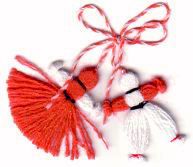Reading time: 2 minutes
Today is the first of March, and we, the Bulgarians, observe one special holiday called baba Marta (Grandma March) holiday and I’d like to take the opportunity to wish you happy baba Marta!
Who is baba Marta and what is this holiday about?
In Bulgarian, ‘baba’ means grandma and Marta means March.
Baba Marta (Bulgarian: Баба Марта, “Grandmother March”) is the name of a mythical figure who brings with her the end of the cold winter and the beginning of the spring. Her holiday of the same name is celebrated in Bulgaria on March 1 with the exchange and wearing of martenitsas.
Baba Marta is seen as an old lady who has very contrasting moods. This is related to the weather during the month of March, which is traditionally extremely variable in Bulgaria – warm and sunny weather means that Baba Marta is happy; when she is angry, the winter frost returns.
The majority of the customs connected to Baba Marta aim to make her happy and so bring about spring all the faster.
All Bulgarians celebrate on March 1 a centuries-old tradition and exchange martenitsas on what is called the day of Baba Marta. Eagerly followed on March 1 every single year, the tradition of giving your friends red-and-white interwoven strings brings health and happiness during the year and is a reminder that spring is near.
Celebrated on March 1, Baba Marta (Grandma March) is believed to be a feisty lady who always seems to be grudging at her two brothers, while the sun only comes out when she smiles. As folklore often goes, there are different versions of the Baba Marta tale. One says that on that day she does her pre-spring cleaning and shakes her mattress for the last time before the next winter – all the feathers that come out of it pour on Earth like snow – the last snow of the year. The martenitsa tradition is thought to have been inspired by Bulgaria’s first Khan Asparuh, who sent a white string to his wife to tell her he survived a battle.
People are supposed to take off their martenitsas when they see the first signs that spring has already come – a blooming tree or a stork. When the martenitsa is taken off some tie it to a tree – one that they’d like to be especially fruitful. Others place it under a rock and based on what they find there the next morning guess what kind of a year this one would be.
The martenitsa now comes in all shapes and sizes – from Guiness-worth giant building packages to two tiny simple strings gently placed on a newborn’s arm. Children usually compete who will get the most and often walk around more ornate than a Christmas tree. However, it always bears the same meaning – a lucky charm against the evil spirits of the world, a token for health and a sign of appreciation.
Taken from: Wikipedia’s article about Baba Marta

